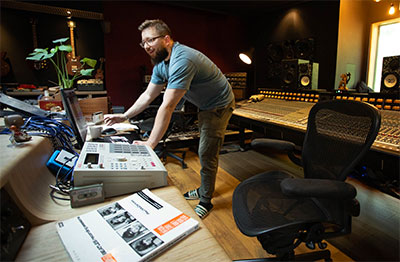British producer, recording engineer and mixing engineer Chris ‘Freemonk’ Webb has incorporated Chord Electronics’ Alto professional headphone amplifier into his monitoring set-up, using the unit to drive both headphone sand the Yamaha NS-10 monitors at his personal Friary Studio.
The equipment at Friary Studio is steeped in history, from SSL console to outboard – evidence that Freemonk prefers an old-school analogue workflow. While this presents its share of challenges, the results that he has achieved in everything from jazz to hip-hop show a producer at the top of his craft.
 He discovered Chord Electronics after talking with fellow producer MsM. ‘Chord Electronics came into my life with a typical nerd chat with MsM, who is a fantastic mixing engineer based in London,’ he recalls. ‘I’d noticed he was using Chord Electronics and I asked him what it was. He gave a very MsM answer – “just go try it”.’
He discovered Chord Electronics after talking with fellow producer MsM. ‘Chord Electronics came into my life with a typical nerd chat with MsM, who is a fantastic mixing engineer based in London,’ he recalls. ‘I’d noticed he was using Chord Electronics and I asked him what it was. He gave a very MsM answer – “just go try it”.’
Freemonk followed that advice, and the Alto amp became part of the workflow at The Friary.
‘I rely on NS-10s quite heavily during tracking, production and mixing,’ Freemonk says. ‘I think they’re horrible, but they do what they’re supposed to, and your ears just get used to hearing certain things on them that are out of place or that need adding. The Alto was so small, and being very honest I was quite sceptical about how it could provide enough power for the NS-10s and have headphone amps. But I had a listen, and it took me down a rabbit hole of wanting Chord everywhere.’
The Alto offers 50W/per channel for close-field monitoring, plus enough drive for its four headphone outputs simultaneously, via one front-panel 3.5mm, one 4.4mm Pentaconn and two 6.35mm outputs. It relies on Chord Electronics’ renowned Ultima amplifier topology with dual-feedforward error-correction technology, which monitors then immediately corrects signals before the output stage, for accuracy and transparency.
‘It’s opened the sound up of the NS-10s, it’s not just about the frequency spectrum it also somehow gave them more depth,’ Freemonk reports. ‘I realised that the amp I was using before was just squashing the sound so that was a real eye-opener. Before I would always switch the NS-10s off when the artists were listening back, but now sometimes I leave them on.’
A further Alto advantage is its portability: ‘Sometimes I track in London in bigger studios and there was a particular studio with a lovely old Trident desk,’ he says. ‘The band were in the same room, so we had to track on headphones. The way that studio was set up, I wasn’t happy with the monitoring I was getting on the headphones. I popped my Alto in the bag, went back to London, and felt like I knew what I was hearing again.
‘I ended up mixing that EP and, when I came back in here – be it on headphones or NS-10s – it was the same feeling again which I wasn’t getting with their current system.’
With the Alto now established in his signal chain, Freemonk is positive about what the Alto unit is adding: ‘It’s just made my life a bit better, which is always good in the world of “this channel’s crackling, the valves gone on that tape machine”, and all this analogue stuff, it’s nice to have something which is a bit of a rock.’
See also:
Chord Electromics Alto

